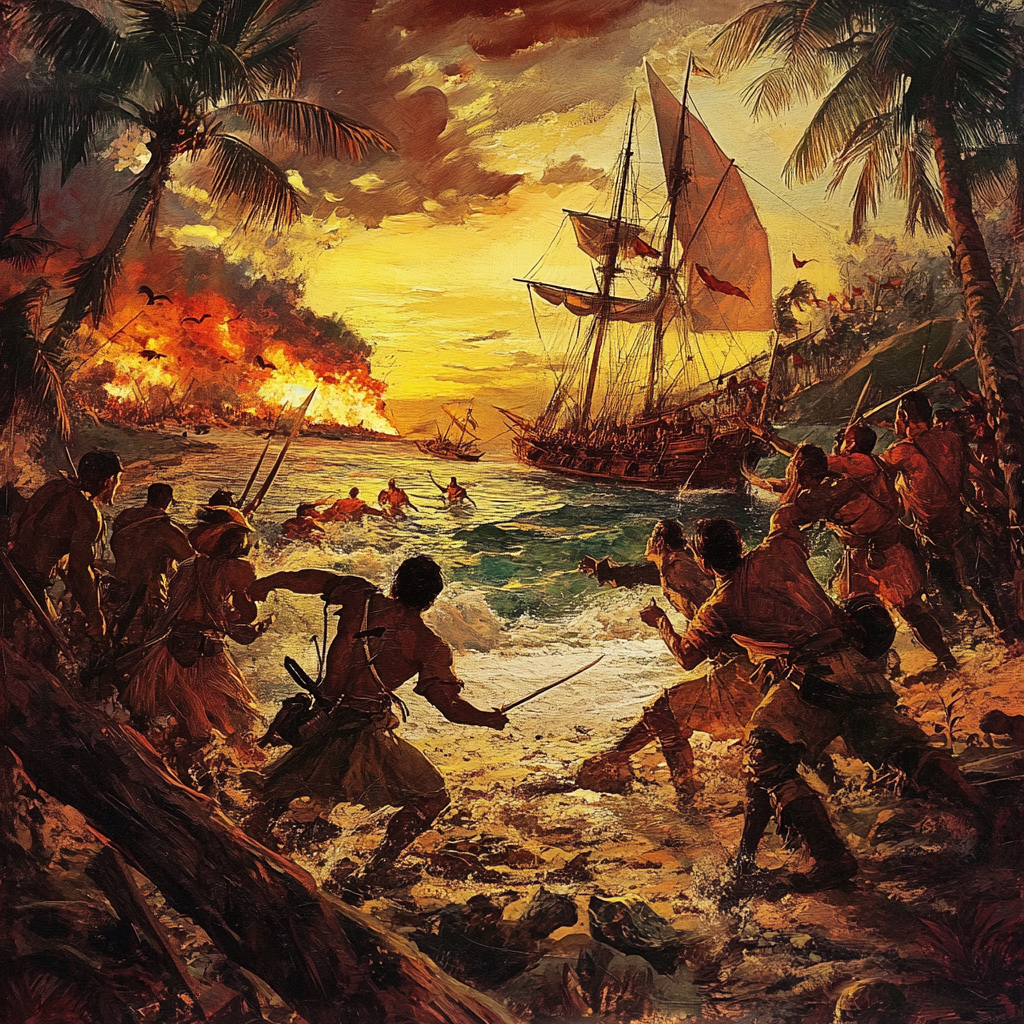
The story of the Battle of Mactan isn’t just a tale of combat; it’s the saga of courage, defiance, and resistance. This 1521 clash would mark a critical moment in the Philippines’ history, forever shaping the legend of a fearless chieftain, Lapu-Lapu, who would become a hero of Filipino independence and identity. But how did this small, coastal island in the Philippines turn into the site of a battle that would reverberate for centuries?
The backdrop of the Battle of Mactan stretches back to the Age of Exploration when European powers were racing to discover and claim new territories, bringing with them the promise of wealth and conquest. In 1521, Ferdinand Magellan, the renowned Portuguese explorer, was leading an expedition under the Spanish crown with an ambitious plan: to find a westward route to the Spice Islands (present-day Maluku Islands) and expand Spanish influence. But, as history would soon reveal, things didn’t go quite as planned.
The Arrival of Magellan
When Magellan and his fleet arrived in the Philippines, they were welcomed in Cebu by local chieftains. Eager to expand Spain’s influence and Christianize these newfound lands, Magellan forged an alliance with Rajah Humabon, the chieftain of Cebu. Humabon, newly converted to Christianity, had his own motives and saw the foreign explorers as powerful allies who could help him assert dominance over neighboring leaders.
One neighboring leader, however, would prove to be an unmovable force. On the small island of Mactan, just across the channel from Cebu, Lapu-Lapu, a local chieftain, ruled with a fiercely independent spirit. He had no interest in submitting to foreign authority or paying tribute to any king across the ocean. This would set him on a collision course with Magellan.
Tensions Rise on Mactan Island
Rajah Humabon, eager to bring Lapu-Lapu to heel, convinced Magellan to assist him in subduing the resistant chieftain. It was a decision that would set the stage for a confrontation unlike any the Spaniards had anticipated. Magellan, confident in the superiority of European weaponry and tactics, saw the battle as a minor skirmish that would end quickly in his favor.
On April 27, 1521, Magellan, with about 50 of his men, sailed toward Mactan at dawn, hoping to launch a surprise attack. As they approached, they encountered an obstacle Magellan had not anticipated—the shallow waters around Mactan, which forced them to land farther from shore than planned. The Spaniards had to wade through chest-deep water to reach the beach, making them vulnerable and slowing their approach. On the shore, Lapu-Lapu and his men, estimated at over 1,000, stood ready.
The Battle Begins
From the very start, the battle was a clash of two vastly different worlds. Magellan’s men, armed with steel swords, shields, crossbows, and muskets, faced off against Lapu-Lapu’s warriors wielding wooden shields, spears, and an indigenous weapon known as the kampilan. The Spaniards’ muskets and crossbows could do damage, but they were cumbersome and ill-suited for close-quarters combat on Mactan’s sandy shores.
As the Spaniards moved forward, Lapu-Lapu and his warriors met them head-on. The battle was brutal, chaotic, and bloody. Magellan, seeing his men falter, tried to inspire them by fighting at the front lines himself. According to historical accounts, he fought valiantly but was struck repeatedly by Lapu-Lapu’s warriors. Eventually, he was overwhelmed, falling to the ground under a flurry of blows. The famous European explorer, who had traveled halfway around the world, would die in the sands of Mactan, far from home.
The Aftermath: A Hero is Born
The Spaniards, shocked by Magellan’s death, retreated, leaving his body behind. The survivors returned to Cebu, where Rajah Humabon’s alliance would crumble in the wake of the defeat. Eventually, they fled the Philippines entirely, bringing news of Magellan’s death back to Spain. For Lapu-Lapu and his people, however, the victory was a significant triumph, one that represented resistance to foreign domination and protection of their homeland.
Today, the Battle of Mactan is remembered as a symbol of Filipino bravery and independence. Lapu-Lapu is celebrated as the first Filipino hero, a figure who refused to bow to an outside power and defended his people with determination. Statues, monuments, and even the name of the city of Lapu-Lapu on Mactan Island pay tribute to the warrior who led his people to victory in one of history’s most unexpected battles.
What began as a routine mission for Ferdinand Magellan ended with a legacy of defiance. The story of the Battle of Mactan is more than just a historical event; it is a reminder of the resilience and courage of a people who stood against insurmountable odds and emerged victorious.








Your point of view caught my eye and was very interesting. Thanks. I have a question for you.